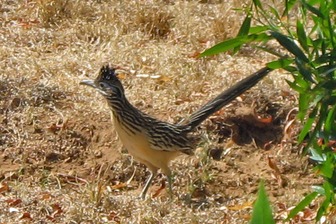Lesser Roadrunner
The Lesser roadrunner resembles the Greater Roadrunner in appearance and habit but is smaller and has a significantly shorter bill. Its breeding range is in southwestern Mexico, and north into the western side of the Sierra Madre Occidental range; also northern Central America, and a disjunct range in the northern Yucatán Peninsula.

Original source: Geococcyx_velox_1875.JPG: LaHoma Simmons
Author: Geococcyx_velox_1875.JPG: LaHoma Simmons
Permission: GNU Free Documentation License
The Lesser Roadrunner is classified as Least Concern. Does not qualify for a more at risk category. Widespread and abundant taxa are included in this category.
The lesser roadrunner is slightly smaller, not as streaky, and has a smaller bill. The bird is terrestrial; although capable of flight, it spends most of its time on the ground. During flight, the wings are short and rounded and reveal a white crescent in the primary feathers. Roadrunners and other members of the cuckoo family have zygodactyl feet (two toes in front and two toes in back). More
The Lesser Roadrunner, Geococcyx velox, is a large, long-legged member of the Cuckoo family, Cuculidae. The Lesser roadrunner resembles the Greater Roadrunner (Geococcyx californiana) in appearance and habit but is smaller and has a significantly shorter bill. Its breeding range is in southwestern Mexico, and north into the western side of the Sierra Madre Occidental range; also northern Central America, and a disjunct range in the northern Yucatán Peninsula. More
Lesser Roadrunner (Geococcyx velox): This beautifully patterned bird is found throughout much of Honduras from near sea level well up into the highlands. It inhabits disturbed areas and scrub and although it is large it can be easily overlooked. It preys on large insects, snakes and lizards, using its speed to chase them down. From Birds of Honduras http://www.birdsofhonduras.com/field_work.html Photo by Larry Wan The Lesser Roadrunner, Geococcyx velox, is a large, long-legged member of the Cuckoo family, Cuculidae. More
Lesser Roadrunners clutch size is typically smaller). Eggs are generally a white color. * Parental care: Roadrunners have bi-parental care. Both sexes incubate the nest and feed the hatchlings, but males incubate the nest at night. For the first one to two weeks after the young hatch, one parent always remains at the nest. More
Aspects of the topic lesser roadrunner are discussed in the following places at Britannica. Assorted References * type of roadrunner (in roadrunner (bird)) The lesser roadrunner (G. velox) is a slightly smaller (46 cm, or 18 in.), buffier, and less streaky bird, of Mexico and Central America. More
Facts about lesser roadrunner: type of roadrunner, as discussed in roadrunner (bird): = The lesser roadrunner (G. velox) is a slightly smaller (46 cm, or 18 in.), buffier, and less streaky bird, of Mexico and Central America. More
species, the lesser roadrunner, that occurs in portions of Mexico and Central America. Other regional names include "paisano" and "chaparral cock." Excerpts from The Birds of Texas by John L. Tveten with permission from Shearer Publishing, Inc. More
Lesser Roadrunners clutch size is typically smaller). Eggs are generally a white color. Roadrunners have bi-parental care. Both sexes incubate the nest and feed the hatchlings, but males incubate the nest at night. For the first one to two weeks after the young hatch, one parent always remains at the nest. After the hatchlings are two to three weeks old they leave and never return to the nest. For a few day thereafter, the parents and young forage together. More
greater and lesser roadrunner, although the greater roadrunner is probably the more well known of the two. These birds have become iconic thanks to their role in the Wile E. Coyote cartoons, and, contrary to popular belief, real roadrunners don't actually say “beep beep,” but rather they communicate through a series of cooing calls and beak clattering. The greater and lesser roadrunner are physically very similar. More
Family : Cuculidae
Genus : Geococcyx
Species : velox
Authority : (Wagner, 1836)

